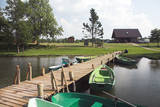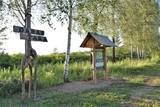| Нo | Название | Описание |
|---|---|---|
|
В лесном хозяйстве Männiku используются местные продукты ‒ прежде всего растительного происхождения. Здесь накоплен многолетний опыт производства продуктов питания из разнообразного растительного сырья, что привлекает в хозяйство гостей со всего мира. Принимаются только группы. |
||
|
No Rīgas dodieties gar Daugavas labo krastu un apciemojiet Trušu Karalisti, kurā trušu mājiņas ir veidotas kā mazas muižas un pilis. Pēc tam dodieties uz Skrīveriem nogaršot mājas saldējumu un apmeklējiet Kokneses pilsdrupas. Nākamajā dienā apmeklējiet privātu mini-zoo ar dažādiem eksotiskajiem dzīvniekiem, pēc tam dodieties uz Raunas cepli, lai redzētu, kā top dažādi māla priekšmeti no sākuma līdz beigām. Vērts apskatīt Cēsis un tās viduslaiku pili. Izstaigājiet Līgatnes dabas takas, kur iespējams redzēt vairākus vietējos savvaļas dzīvniekus. Siguldā bērniem patiks piedzīvojumu parks. Siguldā atrodas arī divas viduslaiku pilis. Pirms atgriešanās Rīgā, apciemojiet zemnieku saimniecību, lai apskatītu kazas, ponijus u.c. dzīvniekus, kā arī nogaršotu kazas piena piena produktus. |
||
|
древнее куршское городище, расположенное в самом центре Алсунги. Свое название оно получило в 1659 году, когда Курземский генерал Берг расположил здесь орудия (пушки), чтобы обстреливать шведские войска, укрепившиеся в Алсунгском замке. Городище высотой 8-10 метров (площадка 22 x 54 м) с великолепным видом на Алсунгскую католическую церковь Святого Михаила и близлежащее озеро Дзирнаву. Вокруг городища вытянулась ярко выраженная терраса, на которой располагались деревянные защитные сооружения. На второй стороне Замковой улицы (к западу от городища) расположено кладбище Калнини с захоронениями 11-13 в.в., исследованными археологами в середине прошлого века. На Дижгабалкалне суйты празднуют Пасху и Лиго (Янов вечер). |
||
|
Interesantā būve, kurai Baltijas valstīs grūti atrast līdzinieku, ir meklējama 2 km ziemeļaustrumos no Kirblas (Kirbla). 307,8 m garo arkveida tiltu pāri Kazari upei (Kasari jõgi) uzcēla 1904. g. deviņu mēnešu laikā. Tajā brīdī to uzskatīja par Eiropas garāko šāda tipa dzelzsbetona tiltu. Tagad to var šķērsot tikai ar kājām vai ar divriteni. Tumšajā diennakts laikā tilts ir skaisti izgaismots! Tā ievērojamais garums ir skaidrojams ar apstākli, ka pavasara palos Kazari palienes applūst lielās platībā. |
||
|
Гауя — это самая красивая река в Латвии, с впечатляющей речной долиной, доходящей в глубине до 80 метров. Живописные обнажения пород песчаника возвышаются над рекой. Гауя — это спокойная река, с всего лишь несколькими маленькими порогами. Катание на лодке для отдыха здесь замечательно. Между Цесисом и Сигулдой, Гауя течет через Национальный парк Гауя. На берегах реки находятся несколько хорошо оборудованных причалов для лодочников, со скамейками, столами, местами для костров, хворостом и информационными стендами. На пути встретятся несколько достопримечательностей культурного наследия — старомодный паром Лигатне, средневековый замок Турайда и поместье Кримулда. |
||
|
Atrodas Labraga – Apriķu ceļa malā. Kāds nostāsts vēsta, ka to 1896. gadā cēlis vietējais muižkungs, kurš vēlējies, lai viņa meitas laulības notiktu baznīcā. Dievnamā atrodas altārglezna "Kristus pie krusta un Sv. Marija Magdalēna", kas gleznota 19. gadsimtā (autors T. Šprengels). |
||
|
Karņicka kalns pēc savas izcelsmes nav kalns, bet gan Daugavas ielejas nogāzes daļa ar labu skatu uz Krāslavas mazstāvu koka apbūvi. Ar šo vietu saistīts traģisks nostāsts par poļu virsnieka Josifa Karņicka un grāfa Plātera meitas mīlestību, kurai nebija lemts piepildīties tā laika „paražu” dēļ. Tā rezultātā abi nelaimīgie nolemj izdarīt pašnāvību. Virsnieks nošaujas, bet Emīliju pēdējā brīdī izglābj kalpone, neļaujot tai izlēkt pa pils logu. J. Karņicka pašnāvības vietā ir uzstādīts piemineklis. Nedaudz tālāk – rietumu virzienā guļ t.s. Austriņa akmens, pie kura 1909. gadā iedvesmojies un radījis latviešu rakstnieks Antons Austriņš. |
||
|
Andrupenes dabas takā var iepazīt sūnas, pārliecināties par sfagnu lielo ūdens uzsūkšanas spēju, gar laipas malām ieraudzīt apaļlapu raseni un purva dzērveni, apskatīt spilves, vaivariņus un purva vārnkāju, kā arī purva pasauli. Takas garums ~ 750m.
|
||
|
Мастерская художницы находится в очень красивом хуторе. Ткёт гобелены и предлагает понаблюдать за ходом работы, заказать, а также приобрести готовые изделия. Многие из них - практические сувениры и используются как хорошие подарки. |
||
|
Усадьба Беркенеле является памятником национального значения и известна как земля детства великого латышского писателя и общественного деятеля Райниса (1865-1929). В 1995 году дом был восстановлен, а с 1996 года он функционирует как дом Райниса в Беркенеле. Детские впечатления отображены в сборнике стихов «Пять эскизных тетрадей Дагды». В наше время в доме Райниса предлагаются экскурсии, творческие мастерские, выставки; посетители могут переодеться в костюмы господ или слуг того времени и т.д. Вокруг дома растет большой фруктовый сад, предлагается программа «Яблочный путь». Особенно здесь ждут детей и молодежь. Из дома открывается прекрасный вид на пейзаж Селии |
||
|
Владельцы базы отдыха «Эзермали» предлагают прекрасную возможность для дневного отдыха на берегу живописного и прозрачного озера Звиргзду без ночлега. Сюда можно приехать на благоустроенный пляж поплавать, покататься на лодке и порыбачить. Дети смогут прокатиться на водном велосипеде. Активный отдых. Деревенская баня. В гостевом доме есть 2 комнаты на 8 человек. 6 кемпинговых домиков, 18 палаточных мест, прокат лодок. |
||
|
В Ошвалки – населенном месте между Юркалне и Сарнате установлен памятный знак «Парус надежды», посвященный тем латышским беженцам (1944 – 1945), которые на рыбацких лодках отправились через Балтийское море в Швецию. Знак установлен на прибрежной дюне между дорогой и морем. |
||
|
Kokneses dabas taka (5,65 km) ved gar Daugavas un Pērses krastiem un savieno Kokneses parku un Likteņdārzu. Pastaigā pa dabas taku var doties no jebkuras sevis izvēlētas vietas, kas vijas cauri Kokneses parkam. Takā izveidotas laipas, tiltiņi, informācijas stendi un norādes. |
||
|
В Мерсраге находился пограничный пост СССР, за которым начиналась зона приграничного режима. От этого поста до наших времен не сохранилось ничего.
|
||
|
This tree is in the park of the Sēja Estate and is one of the four trees in Latvia that have a circumference of more than four metres.
|
||
|
One of the richest sources of sulphurous water in Latvia.
|
||
|
Летний дом и баня с каминным залом на берегу озера Сила. Баня – каминный зал, баня, душ, 2-местная спальня. Летний дом – одна комната с двумя отдельными кроватями, сухой туалет.
|
||
|
At the highest point of Krievkalni (149 metres above sea level), there is a good location for relaxation which offers an impressive view toward the East.
|
||
|
Saimnieks Valentīns Kuklis savā viensētā izveidojis no koka un citiem materiāliem un vēsturiskiem priekšmetiem veidotu brīvdabas kolekciju, kas savākta g.k. no Latgales lauku sētām. Daļa no vēsturiskajiem priekšmetiem ir izvietota saimnieka veidotā muzejā. Piedāvā ekskursiju un stāstījumu par savāktajiem darbarīkiem un sadzīves priekšmetiem. |
||






















